Science and Technology: September 2024 UPSC Current Affairs | Science & Technology for UPSC CSE PDF Download
Neuromorphic Computing
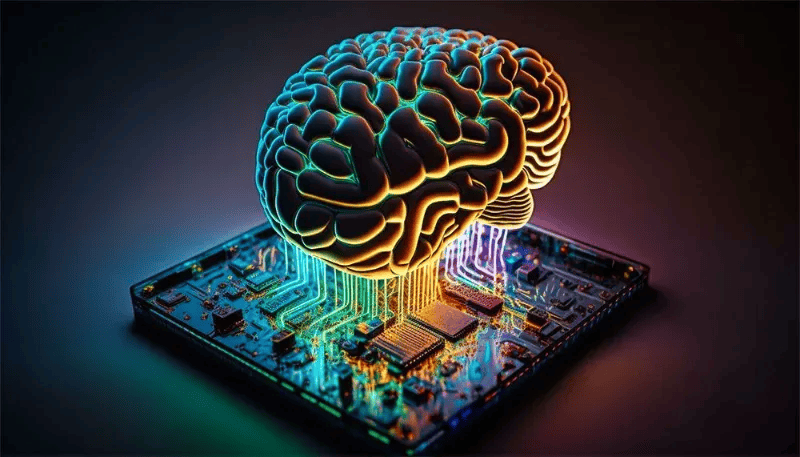
Why in news?
Recently, a team of scientists from Jawaharlal Nehru Centre for Advanced Scientific Research (JNCASR) has developed an Artificial Synapse for Brain-Like Computing, which is a significant advancement in Neuromorphic Computing. They utilized scandium nitride (ScN), a semiconducting material that offers excellent stability and is compatible with Complementary Metal-Oxide-Semiconductor (CMOS) technology, to create a system that emulates brain-like computing.
What are the Significances of the Study?
- Neuromorphic hardware is designed to replicate a biological synapse, which is responsible for monitoring and retaining signals generated by stimuli.
- ScN is employed to construct a device that not only mimics a synapse but also controls the transmission of signals and retains them.
- This innovation presents a new material that can provide stable, CMOS-compatible optoelectronic functions at lower energy costs, making it suitable for industrial applications.
- Traditional computers separate memory storage from processing units, leading to significant energy use and delays when transferring data between these components.
- In contrast, the human brain operates as a highly efficient biological computer, utilizing synapses that serve as both processing and memory storage units.
- As artificial intelligence grows, brain-like computing approaches are crucial to meet the rising demands for computational power.
What is Neuromorphic Computing?
- Neuromorphic Computing draws inspiration from the human brain and the nervous system, a concept that emerged in the 1980s.
- This field focuses on designing computers that mimic the architectures found in biological systems.
- Neuromorphic devices can operate similarly to the human brain while requiring minimal space for software.
- The development of Artificial Neural Networks (ANN) has reignited interest in neuromorphic computing.
Working Mechanism:
- Neuromorphic computing employs Artificial Neural Networks (ANN) composed of numerous artificial neurons that resemble those in the human brain.
- These neurons communicate through layers, transforming inputs into outputs via electrical spikes or signals, based on Spiking Neural Networks (SNN) architecture.
- This design allows machines to imitate the neuro-biological connections within the human brain, performing tasks like visual recognition and data analysis efficiently.
- Neuromorphic computing paves the way for advancements in technology and rapid progress in computer engineering.
- This concept has been transformative in the field of Artificial Intelligence, where machine learning techniques enhance information processing and enable computers to leverage improved and larger technologies.
High Altitude Pathogens
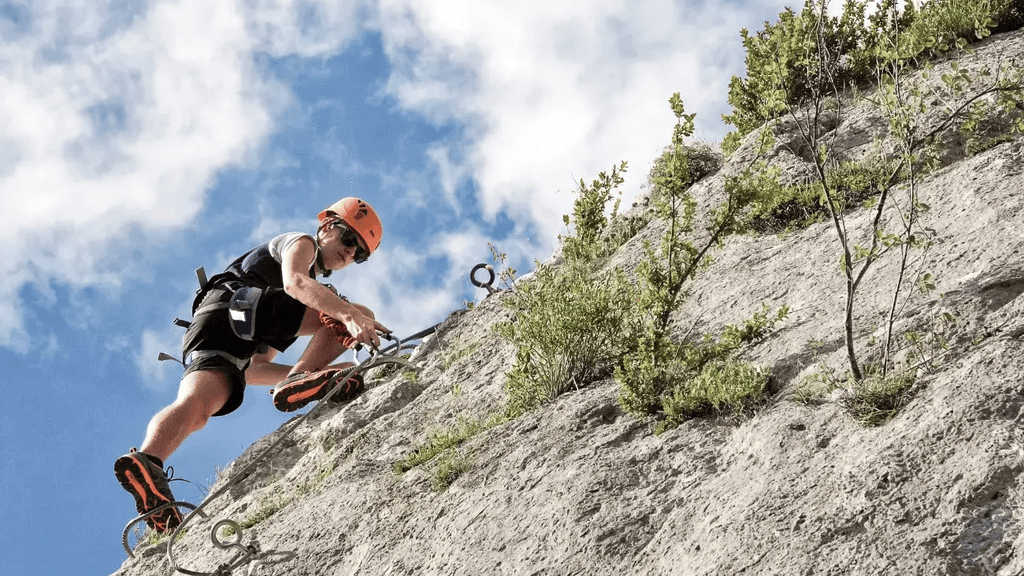
Why in News?
Recent research conducted over Japan at elevations reaching 10,000 feet has uncovered various types of bacteria and fungi in the atmosphere, which may be linked to cases of Kawasaki disease. Since the 1920s, scientists have been examining airborne microbes, capturing spores and other biological particles that drift in the air.
What are the Key Facts about the Study?
- Air Sampling Over Japan:
- Researchers undertook flights to gather airborne particles over the Sea of Japan, concentrating on air masses originating from China.
- The samples revealed the presence of a unique mineral named hafnium, which is likely sourced from Chinese mining activities.
- Northeastern China appears to be a major contributor to airborne pathogens, attributed to its extensive agricultural practices, livestock farming, and soil erosion.
- Connection to Kawasaki Disease:
- The study was prompted by previous research that indicated a rise in Kawasaki disease cases in Japan coinciding with winds from northeastern China.
- This observation suggests that airborne elements carried by these winds may be contributing factors to the disease.
What is Kawasaki Disease?
- About:
- Kawasaki disease, also referred to as Kawasaki syndrome, is characterized by inflammation in the walls of blood vessels that transport blood throughout the body.
- This inflammation can elevate the risk of blood vessel damage, such as tearing or narrowing, which restricts blood flow to various tissues and organs.
- Prevalence:
- The disease predominantly affects children between the ages of 6 months and 5 years.
- In the United States and Canada, it occurs in approximately 10 to 20 cases per 100,000 children under 5, whereas in Japan, Korea, and Taiwan, the prevalence increases to about 50 to 250 per 100,000 children in the same age group.
- Causes:
- The precise causes of Kawasaki disease remain unclear; however, it is believed to be associated with bacterial or viral infections, environmental influences, or genetic factors.
Fecal Microbiota Transplantation

Why in news?
The use of fecal matter as a therapeutic approach, referred to as fecal microbiota transplantation (FMT), is gaining recognition as a transformative solution for gut disorders. Despite its initially controversial nature, India is making advancements in this area, with FMT significantly improving patients' lives, although challenges persist.
What is Fecal Microbiota Transplantation?
- FMT entails transferring fecal material from a healthy donor into the gastrointestinal system of a patient suffering from an unbalanced or unhealthy gut microbiota.
- The main aim is to repopulate the recipient's gut with beneficial bacteria sourced from the donor, thereby aiding the restoration of a healthy microbiome and enhancing gut health.
Benefits
- The human gut hosts a complex community of microorganisms that are essential for digestion, immune function, and safeguarding against harmful pathogens.
- FMT can rectify imbalances in the gut microbiome, often disrupted by antibiotics, steroids, or infections, such as those caused by Clostridium difficile, which can lead to diarrhea, colitis, and severe bowel issues.
- By introducing healthy bacteria, FMT aims to restore equilibrium and improve overall gut functionality.
Challenges and Limitations
- Currently, FMT lacks regulation by major health bodies like the Indian Council of Medical Research (ICMR), raising issues related to standardization and safety.
- The procedure necessitates rigorous donor screening to mitigate risks, including the potential for infectious diseases and microbiome diversity concerns.
- The inherent 'yuck' factor associated with fecal material continues to deter many patients, despite the demonstrated effectiveness of the treatment.
Future of FMT
- Researchers emphasize the necessity for further studies to comprehensively understand the role of microbiomes and to formalize FMT as a standard treatment modality.
- Conducting trials and investigations is crucial to refine the protocols and ensure the safety and efficacy of FMT.
- There is a pressing need for comprehensive guidelines and protocols to standardize the practice and address ethical considerations.
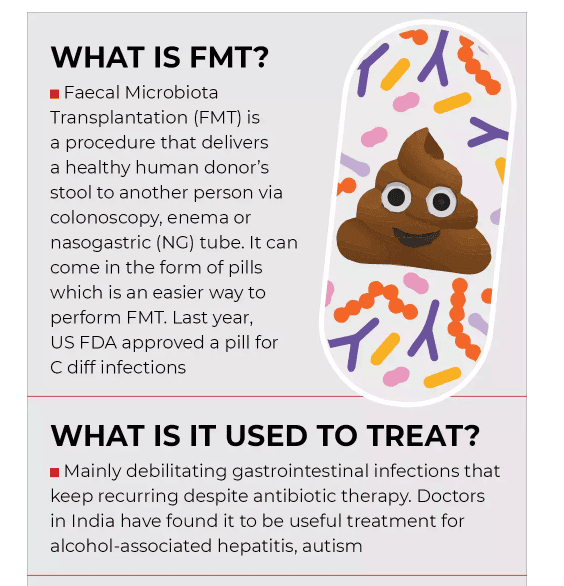
National Blockchain Framework Launched

Why in news?
Recently, the Ministry of Electronics and Information Technology (MeitY) introduced the National Blockchain Framework (NBF). This initiative includes the launch of the Vishvasya-Blockchain Technology Stack, the National Blockchain Framework Lite (NBFLite), and the Praamaanik National Blockchain Portal.The National Blockchain Framework (NBF) serves as a digital platform designed to enhance the security of digital governance through blockchain technology, ensuring transparency and trust in public services.
The additional launches related to NBF include:
- Vishvasya-Blockchain Technology Stack: This provides Blockchain-as-a-Service (BaaS) with a distributed infrastructure that supports various blockchain applications.
- NBFLite: A lightweight blockchain platform aimed at startups and academic institutions to facilitate rapid prototyping, research, and capacity building in blockchain applications.
- Praamaanik: An innovative solution that utilizes blockchain technology to verify the origin of mobile applications.
- National Blockchain Portal: A resource launched to streamline access and integration with various blockchain resources.
Benefits of the NBF include:
- Enhancing Security and Transparency: The NBF is intended to improve the security, trust, and transparency of citizen services, aligning with the Government of India's mission to provide reliable digital public services.
- Transforming Governance through Blockchain: MeitY has urged the expansion of NBF applications across different states and departments, while also exploring new platforms and applications that can be integrated into the framework.
- Tackling Research and Development Challenges:The framework addresses several challenges, such as:
- The necessity for skilled personnel to develop blockchain applications.
- Research challenges concerning security, interoperability, and overall performance.
What are the Components of the Vishvasya-Blockchain Technology Stack?
- Distributed Infrastructure: Hosted across geographically distributed NIC Data Centers located in Bhubaneswar, Pune, and Hyderabad.
- Core Framework Functionality: Offers essential blockchain operations and services.
- Smart Contracts & API Gateway: Enables the creation and management of smart contracts and application interfaces.
- Security, Privacy & Interoperability: Ensures data integrity and secure communication across platforms.
- Applications Development Offering BaaS: Facilitates the development and deployment of blockchain applications under the BaaS model.
What is Blockchain as a Service (BaaS)?
Blockchain-as-a-Service (BaaS) refers to a third-party cloud-based infrastructure and management service for businesses developing and operating blockchain applications.
Benefits of BaaS include:
- Simplification of Tasks: Companies can utilize the BaaS platform to quickly create and deploy blockchain applications without needing to manage complex infrastructure.
- Cost Savings: BaaS allows for cost-effective and efficient use of blockchain technology, promoting secure and transparent innovation and service enhancement.
- Operational Agility and Scalability: BaaS provides blockchain infrastructure that is flexible and scalable, adapting to changing application and user requirements.
Use of Ayurvedic Whole System in Rheumatoid Arthritis
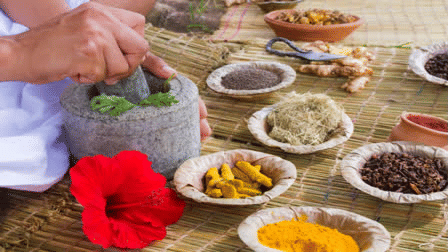
Why in news?
Recently, a study has brought to light the effectiveness of the Ayurvedic Whole System (AWS) in managing Rheumatoid Arthritis (RA), a chronic autoimmune disorder. The research indicates that AWS not only alleviates RA symptoms but also aids in restoring normal metabolic balance in patients. This presents a promising complementary approach to traditional medical treatments.
What are Key Facts About Rheumatoid Arthritis?
- About: Rheumatoid Arthritis is a chronic inflammatory condition that affects the lining of joints, causing painful swelling which may lead to bone erosion and joint deformity.
- In some cases, the disease can affect various body systems including the skin, eyes, lungs, heart, and blood vessels.
- RA occurs when the immune system malfunctions and attacks the synovium, the lining of the joints.
- Significance of the Study:
- The study supports the Ayurvedic principle of 'Samprapti Vighatan', which involves dismantling the disease-causing process and restoring the body's 'Doshas' (bio-energies).
- This research is crucial as it investigates the potential for reversing the pathology of RA through the Ayurvedic whole-system approach.
Key Clinical Improvements Observed:
- Disease Activity Reduction: A significant decrease in the Disease Activity Score, which assesses the severity of RA, was noted.
- Decrease in Joint Inflammation: There was a reduction in both the total number of swollen and tender joints among patients receiving AWS treatment.
- Reduction in Toxins: The Ama Activity Measure (AAM) Score, which measures toxins in the body, showed a significant decrease after intervention, indicating reduced systemic inflammation and toxicity.
- Metabolic Profile Shifts: Following AWS treatment, imbalanced metabolic markers began to align with those seen in healthy individuals, suggesting a return to a balanced metabolic state.
- First-of-its-Kind Evidence: This study is the first to clearly demonstrate the clinical effectiveness of AWS in managing RA, showcasing the dual benefit of symptom alleviation and metabolic normalization, which could lead to long-term positive results for patients.
What is the Ayurvedic Whole System?
- Ayurveda is a traditional Indian system of medicine that has stood the test of time.
- The term 'Ayurveda' translates to 'the knowledge of life', composed of two Sanskrit words: 'Ayu' meaning 'Life' and 'Veda' meaning 'Knowledge' or 'Science'.
- Ayurveda is a holistic medical system, focusing on a natural approach to health and well-being.
- Ayurvedic Strategy:
- Ayurveda is based on the premise that individuals possess specific life forces (doshas) and that everything in the universe is interconnected.
- An imbalance in one aspect can impact another, potentially leading to illness.
- Ayurveda primarily utilizes nutrition, lifestyle modifications, and natural treatments to help restore balance and promote health.
- Three Principal Energies (Doshas):
- Vata: Governs functions such as breathing, blinking, muscle movement, and fluid circulation.
- Pitta: Regulates digestion, absorption, nutrition, and body temperature.
- Kapha: Manages the body's structural components, lubricates joints, moisturizes the skin, and supports immune functions.
India’s first Reusable Hybrid Rocket named RHUMI-1 launched
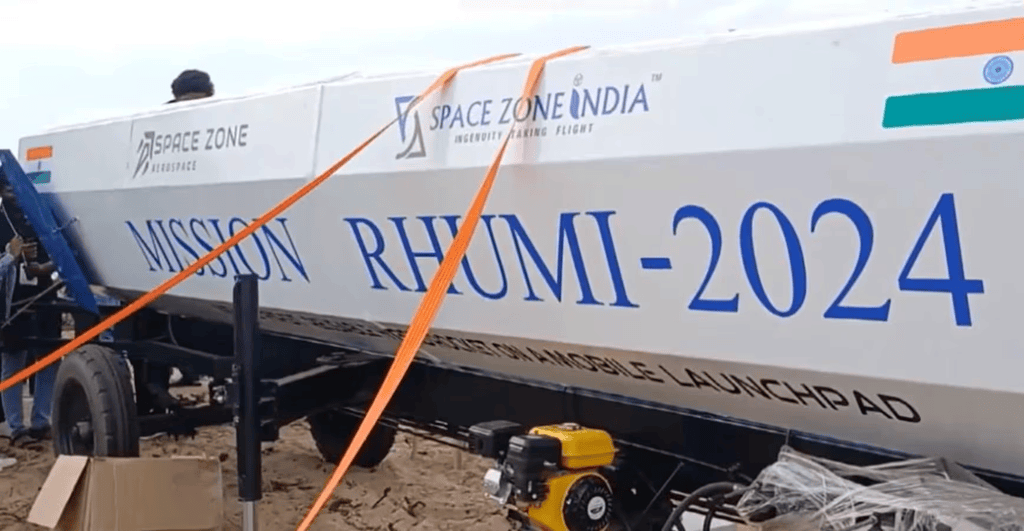
Why in News?
On September 12, 2024, India's first reusable hybrid rocket, RHUMI-1, was successfully launched from Thiruvidandhai in Chennai. This initiative was spearheaded by Space Zone India, a startup based in Tamil Nadu, in collaboration with the Martin Group. The launch utilized a mobile launcher and carried a total of three Cube Satellites and fifty PICO Satellites, which are designed to gather vital data related to global warming and climate change.Cube satellites are a type of nanosatellite, typically weighing between 1 to 10 kilograms, while Pico satellites are even smaller, generally weighing between 0.1 to 1 kilogram.
Features of RHUMI-1
- Hybrid Rocket Engine: RHUMI-1 employs a hybrid rocket engine that combines solid and liquid propellants, which enhances efficiency and reduces operational costs.
- Adjustable Launch Angle: The rocket can adjust its launch angle from 0 to 120 degrees, allowing for precise control over its trajectory.
- Electrically Triggered Parachute System: This innovative and eco-friendly descent mechanism ensures the safe recovery of the rocket's components.
- Environment Friendly: RHUMI-1 is designed to be 100% pyrotechnic-free, utilizing no TNT in its operation.
Reusable Rockets
- Reusable rockets are designed to release their payload, return safely to Earth, and be launched again with new payloads.
Benefits
- Cost Savings: Utilizing reusable rockets can reduce costs by up to 65% compared to building a new rocket for every launch.
- Reduce Space Debris: By minimizing the number of discarded rocket components, reusable rockets help decrease space debris.
- Increased Launch Frequency: The reduced turnaround time enables the rocket to be launched more frequently.
Astra Mark 1 Missiles
The Indian Air Force has approved the production of 200 Astra Mark 1 missiles, which are a class of Beyond Visual Range (BVR) Air-to-Air Missile (AAM) systems. These missiles are designed to be mounted on fighter aircraft, with the ASTRA Mk-I Weapon System being integrated with the SU-30 Mk-I aircraft. The missile boasts a range of 80 to 110 kilometers and is specifically engineered to engage and destroy highly maneuverable supersonic aircraft. This missile system has been developed by the Defence Research and Development Organisation (DRDO) and is manufactured by Bharat Dynamics Limited.
Man-Portable Anti-Tank Guided Missile (MPATGM)
Recently, the Defence Research and Development Organisation (DRDO) successfully conducted a test firing of the indigenously developed Man-Portable Anti-Tank Guided Missile (MPATGM). This missile system is designed to be shoulder-launched and is portable, making it particularly effective against enemy tanks and armored vehicles. It comprises a launcher, a target acquisition system, and a fire control unit. The MPATGM is equipped with advanced infrared homing sensors and integrated avionics, making it versatile for operations during both day and night. Furthermore, it features a high-explosive anti-tank (HEAT) shaped charge warhead, enhancing its effectiveness against armored threats.
GAURAV
The Defence Research and Development Organisation (DRDO) has recently conducted a successful maiden flight test of the Long Range Glide Bomb named 'GAURAV' from the Su-30 MK-I platform. This advanced glide bomb, which weighs around 1,000 kg, is capable of striking targets at significant distances. After being launched, the glide bomb navigates towards its target using a highly accurate hybrid navigation system that incorporates data from both the Indian Navigation System (INS) and the Global Positioning System (GPS).
Exercises in News
- Tarang Shakti: The Indian Air Force hosted Phase-I of Exercise Tarang Shakti at Sulur airbase in Tamil Nadu. This is the first multinational air exercise aimed at showcasing India's defense capabilities and fostering interoperability among participating militaries. The IAF plans to conduct this exercise biennially.
- Udara Shakti: This is a joint air exercise involving Malaysia.
- Parvat Prahaar: The Indian Army is conducting 'Parvat Prahaar' exercise in Ladakh, which focuses on high-altitude warfare and operations. This exercise involves various military units and equipment to ensure readiness along the India-China border.
- Mitra Shakti: This annual military exercise with Sri Lanka aims to enhance the operational proficiency of both armies by facilitating the exchange of skills, experiences, and best practices.
- Khaan Quest: The Indian army will participate in the 21st edition of this multinational military exercise, to be conducted in Ulaanbaatar, Mongolia.
- Maritime Partnership: Recently, the Indian Naval Ship Tabar took part in a maritime Partnership Exercise (MPX) with Russia.
Ambipolar Electric Field

Why in news?
Recently, the National Aeronautics and Space Administration (NASA) has made a groundbreaking discovery by detecting Earth's hidden ambipolar electric field for the first time. This electric field plays a vital role in driving the "polar wind," which sends charged particles into space at supersonic speeds. The findings, published in the journal Nature, represent a significant advancement in our understanding of Earth's ionosphere and its interactions with the surrounding space.
What is the Ambipolar Electric Field?
- Definition: The ambipolar electric field is a weak electric field that spans the entire planet, influencing the movement of charged particles within Earth's atmosphere. It is considered as fundamental to the atmosphere as gravity and magnetism. This field was first theorized in the 1960s.
- Mechanism: Located at an altitude of approximately 150 miles, this electric field interacts with ions and electrons. It prevents charge separation and facilitates the lifting of certain ions to heights sufficient for them to escape into space. This ambipolar field operates bidirectionally, assisting in the upward movement of ions while drawing electrons downward, thereby maintaining a connection between them. The overall effect is an increase in the height of the atmosphere.
- Detection: NASA confirmed the existence and measured the strength of the ambipolar field through a suborbital rocket launched as part of the Endurance mission.
How does the Ambipolar Field Affect Earth's Atmosphere?
- Increased Scale Height: The ambipolar electric field enhances the "scale height" of the ionosphere by 271%. This increase means that the ionosphere remains denser at higher altitudes than it would without this electric field. The greater density is a contributing factor to the polar wind, which propels charged particles into space.
- Ionosphere: This is a layer of the upper atmosphere rich in charged particles. The polar wind is characterized as a bidirectional outflow of thermal plasma from the high-latitude ionosphere to the magnetosphere, primarily consisting of hydrogen, helium, and oxygen ions, along with electrons.
- Effect on Hydrogen Ions: The ambipolar field exerts a force that is 10.6 times greater than that of gravity on hydrogen ions. This substantial force propels these ions into space at supersonic speeds, significantly enhancing the process of atmospheric escape.
- Broader Implications: Gaining an understanding of the ambipolar electric field is crucial for insights into the evolution of Earth's atmosphere. This knowledge can also be applied to studying other planetary atmospheres, such as those of Venus and Mars. Additionally, it may aid in identifying which planets have the potential to support life.
BioE3 Policy and Biotechnology in India
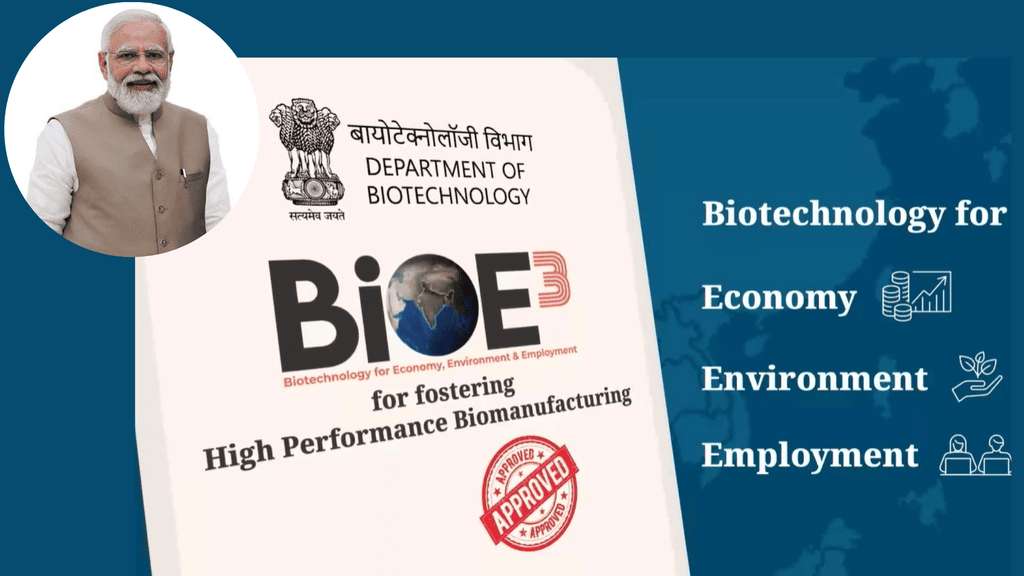
Why in News?
Recently, the Union Cabinet approved the proposal ‘BioE3 (Biotechnology for Economy, Environment and Employment) Policy for Fostering High-Performance Biomanufacturing’ of the Department of Biotechnology. Alongside the BioE3 Policy, the Union Cabinet also merged three schemes of the Science & Technology Ministry into a single scheme, called Vigyan Dhara, with a financial outlay of Rs 10,579 crore until 2025-26.
What is BioE3 Policy?
- About: The BioE3 policy is designed to promote high-performance biomanufacturing, which includes the creation of bio-based products across different sectors. It supports national objectives like achieving a 'Net Zero' carbon economy and advancing sustainable growth through a circular bioeconomy.
- Objectives:
- Encourages innovation in research and development (R&D) and entrepreneurship.
- Establishes Biomanufacturing & Bio-AI hubs and Biofoundries.
- Aims to expand India's skilled biotechnology workforce.
- Aligns with 'Lifestyle for Environment' initiatives.
- Focuses on developing regenerative bioeconomy models.
- Targets job creation, especially in tier-II and tier-III cities, through biomanufacturing hubs that utilize local biomass.
- Promotes ethical biosafety and global regulatory standards to enhance India's competitiveness in biotechnology.
- Core Themes of the BioE3 Policy:
- Bio-Based Chemicals and Enzymes: Development of advanced bio-based chemicals and enzymes to mitigate environmental issues.
- Functional Foods and Smart Proteins: Innovations aimed at improving nutrition and food security.
- Precision Biotherapeutics: Advancements in precision medicine to enhance healthcare outcomes.
- Climate Resilient Agriculture: Promoting agricultural practices that withstand climate change while ensuring food security.
- Carbon Capture and Utilization: Developing technologies for effective carbon capture and its application across industries.
- Futuristic Marine and Space Research: Expanding research in marine and space biotechnology to discover new biomanufacturing opportunities.
What is the Vigyan Dhara Scheme?
- Background: The Department of Science & Technology (DST) serves as the nodal department for coordinating and promoting science, technology, and innovation in India. The central sector umbrella schemes implemented by DST have been unified into the 'Vigyan Dhara' scheme.
- Objectives and Goals:
- The consolidation into Vigyan Dhara aims to enhance fund utilization and synchronization among various sub-schemes.
- This scheme seeks to broaden the R&D base and increase the number of Full-Time Equivalent (FTE) researchers.
- It focuses on boosting women’s participation in Science, Technology, and Innovation (STI) to achieve gender parity.
- All programs under Vigyan Dhara align with DST's five-year goals and contribute to the vision of "Viksit Bharat 2047," which aims for a developed India by 2047.
- Complementing the BioE3 Policy:
- Enhances science and technology institutional infrastructure and develops human resources.
- Supports basic and translational research in sustainable energy, water, and other critical areas.
- Encourages innovation from schools to industries and promotes collaboration among academia, government, and industry.
What is Biotechnology?
Biotechnology integrates biology with technology, utilizing cellular and biomolecular processes to develop products and technologies that improve our lives and protect the environment.
- Benefits:
- Healthcare Advancements: Medical Biotechnology (Red Biotech) facilitates the creation of advanced medications, vaccines, and therapies, including personalized medicine and targeted cancer treatments. It also allows for rapid vaccine production, demonstrated during the Covid-19 pandemic.
- Agricultural Improvements: Agricultural Biotechnology (Green Biotech) focuses on genetic modification to develop crops resistant to pests, diseases, and environmental stresses like drought, thus enhancing food security. Examples include genetically engineered crops like Golden Rice, which is fortified with vitamin A to combat malnutrition.
- Environmental Sustainability: Biotechnology employs microorganisms for bioremediation to clean up pollutants, such as oil spills and heavy metals, thereby restoring ecosystems.
- Industrial Biotechnology (White Biotech): This applies biotechnology in industrial processes, producing biofuels, bioplastics, and biodegradable materials, focusing on sustainability through cleaner production methods and waste recycling.
- Economic Growth: The biotech sector promotes economic growth by generating employment in research, development, and manufacturing. Countries investing in biotechnology are at the forefront of innovations, gaining a competitive edge in global markets.
- Climate Change Mitigation: Certain biotechnologies can capture and utilize atmospheric carbon dioxide, contributing to climate change mitigation. They also aid in producing cleaner biofuels, reducing dependency on fossil fuels.
- Innovation in Materials: Biotechnology allows for the engineering of novel materials, such as bio-based fibers and high-performance composites, applicable in various industries.
What is the Current State of Biotechnology in India?
- Biotechnology Hub: India ranks among the top 12 biotechnology destinations globally. The Covid-19 pandemic accelerated growth in this sector, leading to advancements in vaccines and diagnostics. In 2021, India registered a record number of biotech startups, reaching 1,128 new entries, the highest since 2015, with projections to reach 10,000 by 2025.
- Bioeconomy: The bioeconomy in India has surged from USD 10 billion in 2014 to over USD 130 billion in 2024, with expectations to reach USD 300 billion by 2030. The biopharma segment constitutes the largest share, accounting for 49% of the total value, estimated at USD 39.4 billion.
- Bioresources: India’s rich biodiversity, particularly in the Himalayas and its extensive coastline, offers significant advantages for biotechnology. The Deep Sea Mission aims to explore marine biodiversity.
- Government Initiatives:
- National Biotechnology Development Strategy 2020-25
- National Biopharma Mission
- Biotech-KISAN Scheme
- Atal Jai Anusandhan Biotech Mission
- One Health Consortium
- Biotech Parks
- Biotechnology Industry Research Assistance Council (BIRAC)
- Genome India Project
Recent R&D Achievements in Applied Biotechnology:
- ADVIKA Chickpea Variety: A drought-resistant chickpea variety was developed that enhances seed weight and yield during drought conditions.
- Accel Breed Facility: A state-of-the-art facility in Punjab Agricultural University (PAU), Ludhiana, accelerates crop improvement efforts.
- Indigenous Vaccines: India has developed several innovative vaccines, including the quadrivalent Human Papilloma Virus (qHPV) vaccine and ZyCoV-D (a DNA vaccine). Additionally, the mRNA-based Omicron booster, GEMCOVAC-OM, was introduced.
- Gene Therapy: India launched its first gene therapy clinical trial for Hemophilia A.
- Novel Blood Bag Technology: Researchers at inStem, Bengaluru, created specialized sheets that protect stored red blood cells from damage, potentially improving transfusion outcomes.
Future Outlook:
- The biotechnology industry is projected to reach USD 150 billion by 2025 and could grow to USD 300 billion by 2030.
- This sector is expected to contribute significantly to India’s GDP, estimated at around 3.3-3.5%.
- The market for diagnostic and medical devices is anticipated to expand, with the therapeutics sector expected to generate USD 15 billion in bioeconomic activity by 2025.
- The growth of biotech incubators and support for startups is expected to drive innovation across health, agriculture, and industrial sectors.
What are the Challenges for Biotechnology in India?
- Strategic Roadmap Development: There is a need for a comprehensive strategic roadmap for biotechnology that outlines competitive sectors and specific R&D requirements. Significant advancements are required in crop improvement and therapeutics, akin to the success of the White Revolution.
- Bio-Networking: Enhancing interaction among biotechnology firms is crucial to address issues like intellectual property rights and ensuring biosafety and bioethics.
- Human Resources: There is a shortage of specialized human resources in biotechnology, particularly in remote areas.
- Regulatory Burden: India's regulatory framework for biotechnology is complex and slow, especially concerning genetically modified organisms (GMOs), which can lead to delays in approvals.
- Funding and Investment: While there is government funding available, further investment is essential to support high-risk, innovative research under the Biotechnology Industry Partnership Programme (BIPP).
- IT Integration and Data Management: Biotechnology research requires robust IT support for effective data management, facing challenges in data integration and standardization.
Way Forward
- Expand training initiatives such as the Biotech Industrial Training Programme (BITP) to cultivate a skilled workforce in biotechnology.
- Encourage venture capital investments in biotech startups and early-stage companies.
- Promote public-private partnerships to mobilize resources and accelerate innovation.
- Implement supportive policies and incentives, focusing on regulatory simplification and tax benefits to attract and retain biotechnology firms.
- Utilize initiatives like the Production Linked Incentive (PLI) scheme to enhance competitiveness.
- Work on building a global market presence and brand recognition through strategic partnerships and investments.
- Engage actively in global biotechnology initiatives, such as the Global Alliance for Genomics and Health and the International Association of Plant Biotechnology (IAPB).
- Support the export of biotechnology products and services to international markets.
WHO Guidelines on Antimicrobial Resistance (AMR)
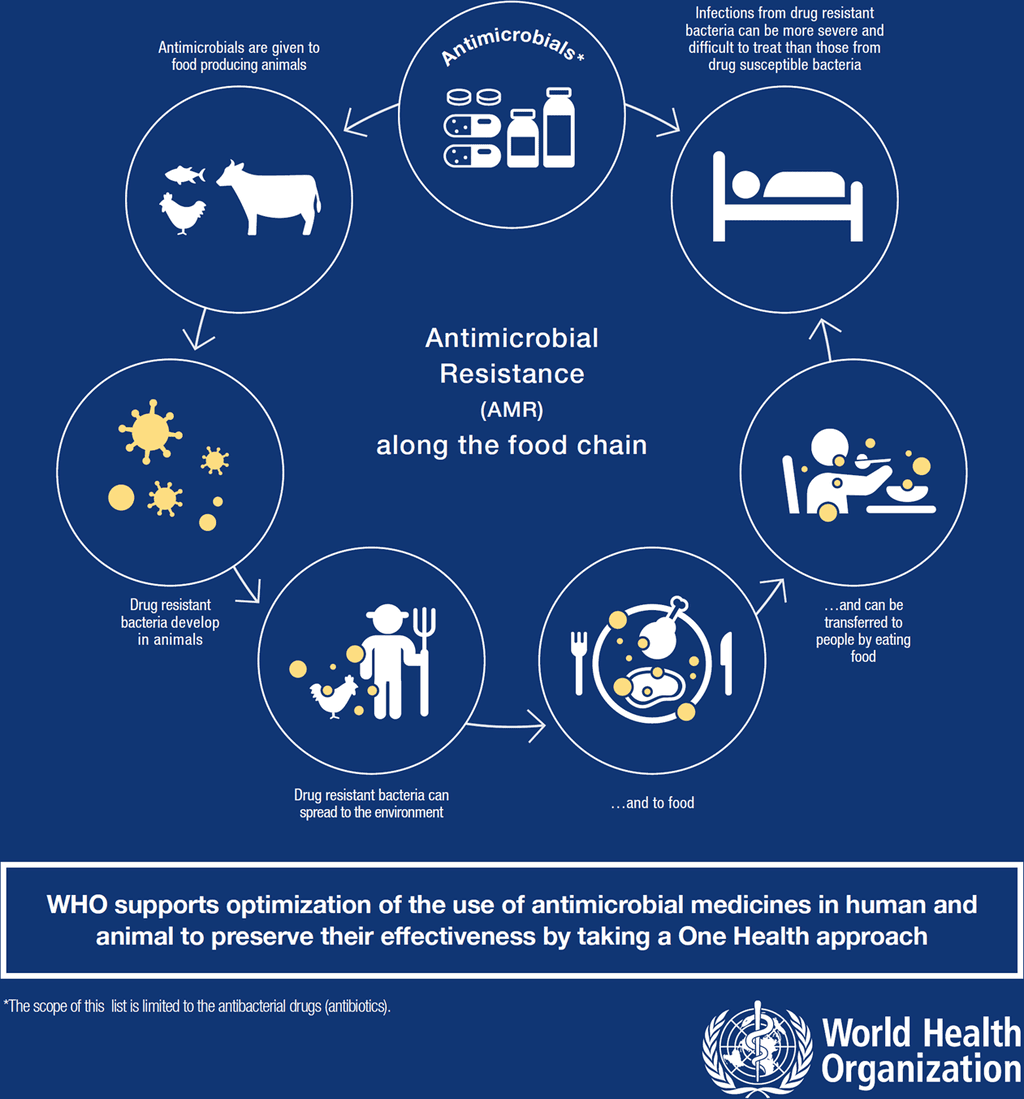
Why in News?
Antimicrobial Resistance, or AMR, is one of the leading threats to global health in the present day. The condition refers to a pathogen developing resistance to an antimicrobial drug, thus leading to the creation of 'superbugs' which can no longer be killed through any traditional treatment. As the United Nations General Assembly High-Level Meeting on AMR, scheduled for September 26, is approaching, the World Health Organization issued guidelines on antibiotic pollution from manufacturing. It is a grim reminder that this crisis has reached proportions that cry out loud for urgent action.
Antimicrobial Resistance (AMR) Crisis in India
- The crisis in India is particularly severe due to several factors, including healthcare infrastructure, cultural practices, and economic constraints.
- The Indian Council of Medical Research (ICMR) has highlighted this serious issue, noting that common germs like E. coli, Klebsiella pneumoniae, and Acinetobacter baumannii are becoming increasingly resistant to existing antimicrobial treatments.
- According to the ICMR's annual report on Antimicrobial Resistance Research and Surveillance Network, this growing problem is making it difficult and expensive to treat regular infections.
- The situation has various impacts, especially affecting patients with comorbidities, who are already dealing with multiple health issues.
What is Antimicrobial Resistance?
- Antimicrobial resistance, or AMR, refers to the ability of germs such as bacteria, viruses, fungi, and parasites to resist the medicines that are meant to kill them or stop their growth.
- This resistance happens when these germs change, often through mutations, which help them survive against antimicrobial agents.
- As a result, common infections become more difficult to treat, leading to:
- Longer illnesses
- Increased spread of infections
- Higher death rates
- The rise of AMR is a major concern for public health because it reduces the effectiveness of standard treatments.
- This situation poses a threat to medical advances that rely on effective antimicrobial therapy, including:
- Surgical procedures
- Cancer treatments
Factors Contributing to Antimicrobial Resistance (AMR):
- Many people in India tend to self-medicate. They often take antibiotics without proper advice from a doctor. This behavior is driven by economic difficulties and limited access to healthcare services.
- Antibiotics are frequently used for viral infections, where they do not work. This misuse leads to a rise in drug resistance.
- Economic Barriers: The high cost and logistical challenges of seeing a doctor push people to seek quick solutions from local chemists. Unfortunately, these chemists often do not provide proper treatments, worsening patients' conditions and contributing to the problem of drug resistance.
- Cultural Practices: A lack of knowledge about antibiotics and cultural beliefs contribute to this issue. Many people think that antibiotics can cure any illness, so they use them even when they are not needed.
- Broad-Spectrum Antibiotics: In India, many healthcare providers prescribe broad-spectrum antibiotics, which treat a wide range of infections. Although they work well for immediate issues, over time, this practice leads to increased resistance.
- Preventive Prescriptions: Surprisingly, a significant number of antibiotics are given to prevent infections rather than to treat them. This unnecessary preventive use greatly contributes to resistance. According to a survey by the NCDC, antibiotics were prescribed to an average of 71.9% of hospital patients, with around 55% of prescriptions being for preventive purposes.
- Empirical Prescription: Many doctors prescribe antibiotics based on symptoms instead of confirmed diagnoses. This leads to the inappropriate use of broad-spectrum antibiotics. This situation arises from poor diagnostic facilities and the urgent need for treatment in many healthcare settings.
- Need for Diagnostic Tests: The introduction of diagnostic tests that accurately identify specific pathogens can help ensure that the right antibiotic is prescribed. This reduces the use of broad-spectrum antibiotics, which contribute to resistance.
- Antibiotic Pollution: The WHO has pointed out that waste from antibiotic production is a significant but often overlooked cause of antimicrobial resistance (AMR). High levels of antibiotics can enter the environment through pharmaceutical waste, leading to the development of resistant bacteria.
- Gaps in Regulation: The impact of pharmaceutical waste on AMR is significant, yet this area is mostly unregulated. There is a need for strict waste management protocols and their rigorous enforcement to reduce this risk.
Impacts of Increasing Antimicrobial Resistance (AMR)
- Antimicrobial resistance has serious effects on public health, healthcare costs, and the global economy.
- Increased Mortality and Morbidity: Diseases that were once easily treated with standard antibiotics are now dangerous and can lead to death. Surgical operations, cancer treatments, and organ transplants also face higher risks due to the potential for severe infections.
- More Costly Healthcare: Infections that are resistant to treatment usually require longer hospital stays, additional tests, and more expensive medications. This leads to a greater demand for intensive care services and isolation, putting pressure on healthcare resources.
- Economic Impact: The economic effects include lower productivity and more absenteeism from work. Higher treatment costs result in increased health insurance premiums and a larger financial burden on both individuals and businesses. On a global scale, antimicrobial resistance is expected to cause significant economic problems, potentially decreasing the world's GDP by trillions of dollars by the year 2050.
- Social Impact: Infections that do not respond to treatment hit the most vulnerable groups the hardest, such as the elderly, children, and people with weakened immune systems. When infections cannot be treated properly, it may lead to a loss of trust in healthcare providers and medical facilities.
Potential Solutions to Combat Antimicrobial Resistance (AMR)
- Multi-dimensional Approach: Tackling antimicrobial resistance (AMR) requires various strategies such as prevention, education, and strict regulations.
- Hygiene Practices: Regular hand-washing, safe food handling, and overall good hygiene can greatly reduce infections, which in turn lowers the need for antibiotics.
- Vaccination: Increasing the availability of vaccines, particularly for pneumococcal diseases and influenza, can prevent bacterial infections that might require antibiotics. Despite the availability of vaccines, many people do not get vaccinated, so raising awareness and improving access is crucial.
- Proper Use of Antibiotics: It is important to continuously educate healthcare workers about the careful use of antibiotics, which should mainly be used for serious cases treated in hospitals. This practice can help slow down the development of antibiotic resistance.
- Public Awareness: Creating awareness among the public about the dangers of self-medication and not completing prescribed antibiotic courses can help reduce the chances of developing resistance.
- Diagnostic Testing: Promoting diagnostic tests to accurately identify the germs causing infections can lead to more precise and appropriate antibiotic use.
- Pharmaceutical Waste Management: It is essential to follow strict rules for disposing of pharmaceutical waste. The World Health Organization (WHO) provides guidelines, but national authorities must ensure these are carefully followed.
- Surveillance and Research: Continuous monitoring of AMR trends and research into new antibiotics and treatments is critical. Understanding how resistance develops, especially from manufacturing processes, can help in creating effective solutions.
- Global Cooperation: AMR is a worldwide issue. Working together across countries to share information, resources, and effective practices will improve the global response to this problem.
Initiatives Taken by the Government to Tackle Increasing AMR
- National Action Plan on Antimicrobial Resistance (2017-2021): The Ministry of Health and Family Welfare has launched the NAP-AMR, which aims to tackle AMR through a comprehensive strategy that includes:
- Boosting awareness and understanding of AMR.
- Improving surveillance of antibiotic use and resistance.
- Lowering the rates of infections.
- Optimizing the use of antimicrobial medicines.
- Investing in new drugs, diagnostic tools, and vaccines.
- Regulatory Measures: The Indian government has placed certain antibiotics under Schedule H1, which requires chemists to keep records of sales and purchases to prevent over-the-counter sales. Additionally, the government has prohibited the use of colistin in poultry farming to reduce resistance related to veterinary practices.
- Awareness Programs: The government has initiated media campaigns to promote the careful use of antibiotics. There are also ongoing educational programs for healthcare professionals to encourage responsible use of antimicrobial medications.
- Control and Research: The National Antimicrobial Resistance Surveillance Network (NARS-Net) has been established to track and monitor resistance patterns throughout the country. Increased funding is being allocated for research into new antimicrobials, alternative treatments, and understanding resistance mechanisms.
- Infection Prevention and Control: Initiatives like Swachh Bharat Abhiyan have been implemented to enhance sanitation and hygiene, which help in reducing infection rates. There is a focus on developing and strengthening guidelines and protocols for infection control in communities and healthcare settings to prevent the spread of resistant pathogens.
- International Collaboration: India works with the World Health Organization and other global organizations to ensure that its strategies for AMR align with international efforts. The country also participates in global research collaborations to create new antimicrobials and diagnostic tools.
Conclusion
- Antimicrobial resistance is a major problem that can reverse many years of advancements in health care.
- To tackle this issue, we need to have strict regulations.
- There must be increased public awareness about the responsible use of antibiotics.
- It is essential to implement strong infection control practices.
- International cooperation is also necessary to effectively combat this challenge.
- Ongoing efforts and constant vigilance are crucial to prevent the spread of resistance.
- The actions taken by the government of India are moving in the right direction to address this issue.
|
90 videos|488 docs|209 tests
|
FAQs on Science and Technology: September 2024 UPSC Current Affairs - Science & Technology for UPSC CSE
| 1. What is neuromorphic computing and how does it differ from traditional computing? |  |
| 2. What are high altitude pathogens and why are they a concern? |  |
| 3. What is fecal microbiota transplantation and what conditions does it treat? |  |
| 4. What is the National Blockchain Framework and what are its potential applications in India? |  |
| 5. How does antimicrobial resistance (AMR) develop and what guidelines has WHO provided to address it? |  |
















